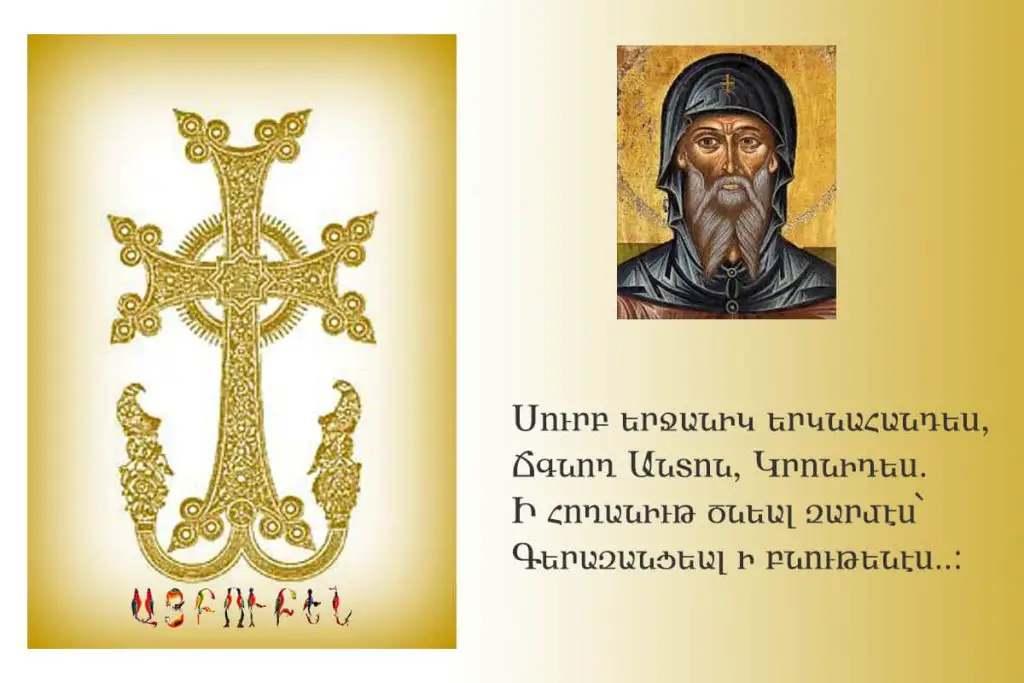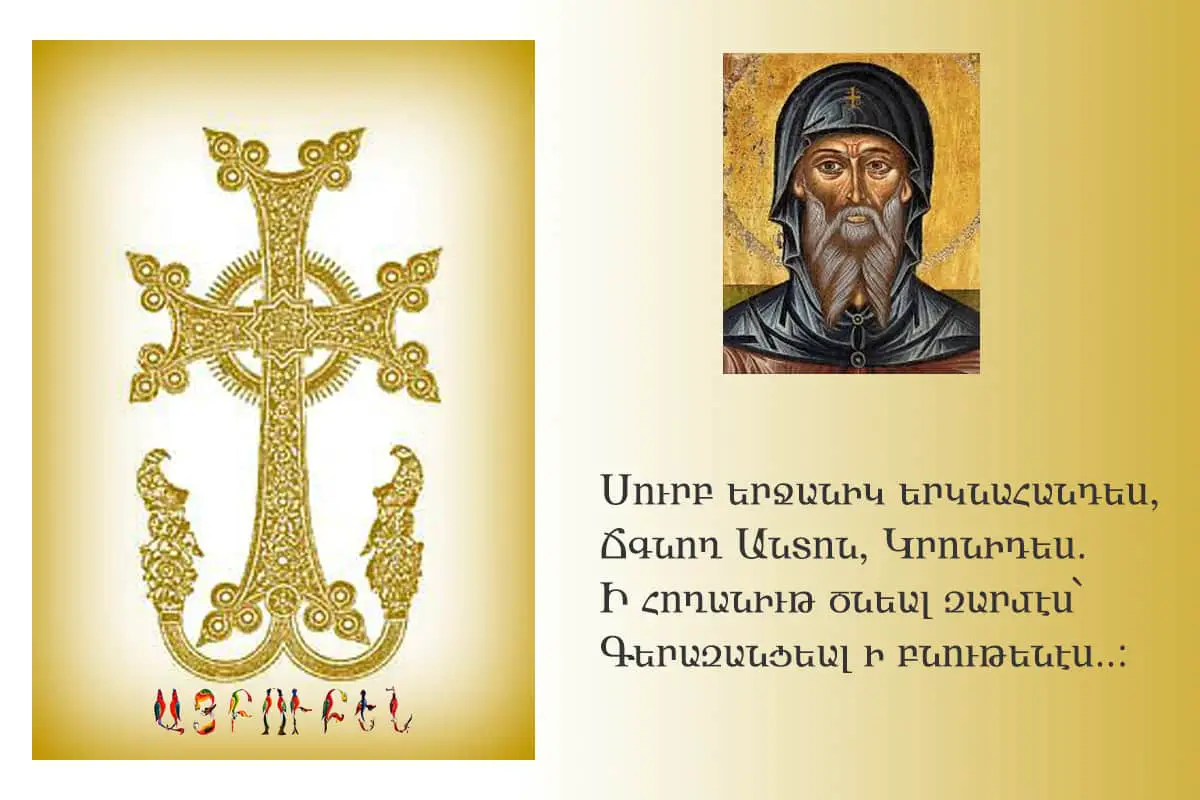Today The Armenian Church pays tribute Celebrates Saint Anthony, Trypon, Parsam, and Vonoprios. They are remembered during the memorial section of the Divine Liturgy.
While it is well-known that our church commemorates 104 Armenian saints throughout the year, it also recognizes and remembers 216 saints from the Universal Church.
Commemorating non-Armenian saints is a testament to the universality of our Church, so it is important to acknowledge them, as they are just as holy and pleasing to God as Armenian saints.

Saint Anthony the Great
Saint Anthony the Great (St. Anton) (251 – 356), a hermit saint of the Apostolic Church celebrated shortly after the Armenian Christmas . In 302, St. Gregory the Illuminator, arriving in Greater Armenia from Caesarea, initiated and brought with him the Greek hermits Anton and Cronies.
Anton and Cronides lived in the monastery of St. Garabed of Mush, founded by Saint Gregory the Illuminator, at the site of the Gisane shrine of the Daron Inaknyan(Nine-Springs Heights).
Here they established a congregation, appointing the son of the Zenob Glak, the prelate of Daron, who was one of their disciples Epiphanes as dean. Anton and Cronidides served in St. Karapet Monastery in Moush for about 15 years, then spent 40 years in the surrounding forests.
Anton’s tomb is pointed out in a chapel near St. Karapet Monastery in Moush. The Armenian Church commemorates St. Anthony and St. Cronides on the Monday following the 5th Sunday of Khachverats, the feast of Raising of the Cross, with other celebrated Armenian hermits.
Although there is no separate hymn dedicated to them, however, the hymn dedicated to Seven Herbivor monks also mentions them.
Saint Trypon, Parsam and Vonoprios Commemoration day
Sometime after the spread of Christianity, the hermit movement began. The hermits were people who were completely devoted to God, heading to deserted places, praying and fasting, overcoming God’s weaknesses with God’s grace, and reaching spiritual perfection.
Years later, hermits also received the gift of healing through miracles and prayers.
St. Anton (Saint Anthony the Great) the Hermit or St. Anton of the desert Desert is the father and founder of hermitage and monastic life. The blessed widow was born in Koma village, Egypt, in 251, to a family of noble parents. After the death of his parents, Anton inherits their wealth.
But one day in the church, he hears the gospel message that Jesus says: “If you want to be perfect, go sell your property and give it to the poor, and you will have treasures in heaven.” (Matt. 19:21)
Guided by this commandment, Anton sells all his possessions and lives in the spirit of prayer, fasting, and charity. After some time, he leaves his native village and settles in a nearby cave where, according to “the book of Acts of saints”, he wages spiritual warfare with the demons that appear to him in the form of wild beasts.
Resisting all temptations, the saint leaves a desolate desert and lives in solitude for 20 years.
Hearing of his way of a sanctified life, many leave their homes headed to the desert. Hearing the prayers of his spiritual brothers, the saint comes out of his hermitage and explains to the brethren the monastic rules, which later become the guide of monastic life.
The saint dies at the age of 105, receiving the holy Halo of heaven, with his infinite faith and great spiritual power becoming an example for Christians of all times.
Like Saint Anthony, there also existed other hermits, who were martyred in the city of Nikia during the reign of Emperor Decos. Saint Trypon, Saint Parsam who lived the mid-5th century in the Syrian desert, and Saint Vonoprios the Egyptian Hermit (4th century) who went to the monastery for some time, then left for the desert, where he lived for 60 years without meeting anyone.
Like other hermits, Vonophrius healed many by prayer and saved them from suffering. That is why this saint is especially prayed for when healing children and having a difficult birth.
The Armenian Apostolic Church gives particular importance to hermits and has festivities dedicated to their memory.
The Armenian and English Translation of the Nicene Creed
Հաւատամք ի մի Աստուած, ի Հայրն ամենակալ, յարարիչն երկնի եւ երկրի, երեւելեաց եւ աներեւութից։
Եւ ի մի Տէր Յիսուս Քրիստոս, յՈրդին Աստուծոյ, ծնեալն յԱստուծոյ Հօրէ, միածին՝ այսինքն յէութենէ Հօր։
Աստուած յԱստուծոյ, լոյս ի լուսոյ, Աստուած ճշմարիտ յԱստուծոյ ճշմարտէ, ծնունդ եւ ոչ արարած։ Նոյն ինքն ի բնութենէ Հօր, որով ամենայն ինչ եղեւ յերկինս եւ ի վերայ երկրի, երեւելիք եւ աներեւոյթք։
Որ յաղագս մեր մարդկան եւ վասն մերոյ փրկութեան իջեալ ի յերկնից՝ մարմնացաւ, մարդացաւ, ծնաւ կատարելապէս ի Մարիամայ սրբոյ կուսէն Հոգւովն Սրբով։
Որով էառ զմարմին, զհոգի եւ զմիտ, եւ զամենայն որ ինչ է ի մարդ, ճշմարտապէս եւ ոչ կարծեօք։
Չարչարեալ, խաչեալ, թաղեալ, յերրորդ աւուր յարուցեալ, ելեալ ի յերկինս նովին մարմնովն, նստաւ ընդ աջմէ Հօր։
Գալոց է նովին մարմնովն եւ փառօք Հօր ի դատել զկենդանիս եւ զմեռեալս, որոյ թագաւորութեանն ոչ գոյ վախճան։
Հաւատամք եւ ի սուրբ Հոգին, յանեղն եւ ի կատարեալն․ Որ խօսեցաւ յօրէնս եւ ի մարգարէս եւ յաւետարանս․ Որ էջն ի Յորդանան, քարոզեաց զառաքեալսն, եւ բնակեցաւ ի սուրբսն։
Հաւատամք եւ ի մի միայն, ընդհանրական եւ առաքելական, Սուրբ Եկեղեցի․ ի մի մկրտութիւն, յապաշխարհութիւն, ի քաւութիւն եւ ի թողութիւն մեղաց․ ի յարութիւնն մեռելոց․ ի դատաստանն յաւիտենից հոգւոց եւ մարմնոց․ յարքայութիւնն երկնից, եւ ի կեանսն յաւիտենականս։
We believe in one God, the Father Almighty, the maker of heaven and earth, of things visible and invisible.
And in one Lord Jesus Christ, the Son of God, the begotten of God the Father, the Only-begotten, that is of the substance of the Father.
God of God, Light of Light, true God of true God, begotten and not made; of the very same nature of the Father, by Whom all things came into being, in heaven, and on earth, visible and invisible.
Who for us humanity and for our salvation came down from heaven, was incarnate, became human, was born perfectly of the holy virgin Mary by the Holy Spirit.
By whom He took body, soul, and mind, and everything that is in man, truly and not in semblance.
He suffered, was crucified, was buried, rose again on the third day, ascended into heaven with the same body, [and] sat at the right hand of the Father.
He is to come with the same body and with the glory of the Father, to judge the living and the dead; of His kingdom, there is no end.
We believe in the Holy Spirit, the uncreate and the perfect; Who spoke through the Law, the prophets, and the Gospels; Who came down upon the Jordan, preached through the apostles and lived in the saints.
We believe also in only One, Universal, Apostolic, and [Holy] Church; in one baptism with repentance for the remission and forgiveness of sins; and in the resurrection of the dead, in the everlasting judgment of souls and bodies, in the Kingdom of Heaven and in the everlasting life.[72]

